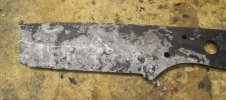- Joined
- Oct 10, 2018
- Messages
- 463
Good morning all. I've been testing a lot of my blades lately on a 1/4" brass rod but have found my forge HT to be unsatisfactory. The edge bends a little and stays bent, but not nearly as much an unhardened blank would (I've done it for comparison). What I realized a few minutes ago was that I've been going way off angle and using a lot of pressure to make this happen. When I matched the sharpening angle, it took an even greater amount of pressure to cause any deflection, and it seems like it springs back (maybe some tiny rolls remain).
Maybe I've answered my own question here, but am I asking too much of my knives or conducting the test improperly? Realistically, is going too far off angle always going to destroy the edge regardless of HT quality?
Maybe I've answered my own question here, but am I asking too much of my knives or conducting the test improperly? Realistically, is going too far off angle always going to destroy the edge regardless of HT quality?


